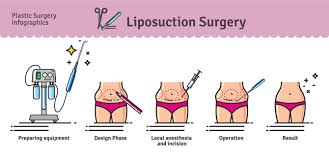Liposuction is one of the most popular cosmetic procedures worldwide, sought after by individuals looking to remove excess fat and improve their body contours. Whether you’re considering liposuction for aesthetic reasons or want to understand more about the process, it’s essential to know how it works, the risks, and the potential benefits. Here’s a comprehensive guide to liposuction.
What Is Liposuction?
Liposuction, also known as lipoplasty or body contouring, is a surgical procedure designed to remove localized fat deposits from specific areas of the body. It is not a weight-loss solution but a cosmetic treatment that helps sculpt and reshape areas that do not respond to diet and exercise.
How Does Liposuction Work?
During a liposuction procedure, a plastic surgeon uses a suction device called a cannula to remove fat cells from targeted areas. The cannula is inserted through small incisions in the skin and is moved back and forth to break up the fat cells, which are then suctioned out of the body. Liposuction can be performed on various areas, including:
Abdomen
Thighs
Buttocks
Arms
Neck and chin
Hips
Back
There are different techniques used in liposuction, each with its advantages and considerations.
Types of Liposuction Techniques
Tumescent Liposuction:
Method: The most common technique, tumescent liposuction involves injecting a large volume of a saline solution mixed with an anesthetic and epinephrine into the targeted area. This helps to minimize bleeding, reduce pain, and make the fat easier to remove.
Benefits: Less blood loss, reduced bruising, and quicker recovery time.
Ultrasound-Assisted Liposuction (UAL):
Method: UAL uses ultrasonic energy to liquefy fat cells before they are removed. This technique is particularly useful for fibrous areas like the back and male chest.
Benefits: More effective in dense areas of fat, less invasive than traditional methods.
Laser-Assisted Liposuction (SmartLipo):
Method: A laser is used to liquefy fat cells, which are then removed through a cannula. The heat from the laser can also promote skin tightening in the treated area.
Benefits: Minimizes skin sagging, less downtime.
Power-Assisted Liposuction (PAL):
Method: PAL involves the use of a mechanically powered cannula that vibrates to help break up fat cells for easier removal.
Benefits: Quicker procedure time, more precise fat removal.
Who Is a Good Candidate for Liposuction?
Liposuction is best suited for individuals who are close to their ideal body weight but struggle with stubborn fat pockets that are resistant to diet and exercise. Ideal candidates typically have:
Good skin elasticity and muscle tone.
Localized fat deposits that do not respond to traditional weight-loss methods.
Realistic expectations about the outcomes of the procedure.
A stable body weight and a healthy lifestyle.
Liposuction is not recommended for individuals with significant weight to lose, nor is it a treatment for obesity or cellulite.

Risks and Potential Complications
While liposuction is generally considered safe when performed by a qualified plastic surgeon, it is still a surgical procedure and carries potential risks. Some of the possible complications include:
Infection: As with any surgery, there is a risk of infection.
Bruising and Swelling: Bruising and swelling are common after liposuction but usually subside within a few weeks.
Contour Irregularities: Uneven fat removal can lead to a bumpy or lumpy appearance in the treated areas.
Numbness or Sensitivity: Temporary or permanent changes in skin sensation may occur.
Blood Clots: Rarely, blood clots can form after surgery, leading to serious complications.
Seroma: A pocket of fluid may accumulate under the skin and may require drainage.
Recovery and Results
The recovery process after liposuction varies depending on the extent of the procedure and the areas treated. Most patients can return to light activities within a few days, but full recovery and final results can take several weeks or even months. Patients are typically required to wear compression garments during the healing process to help reduce swelling and promote smooth contours.
While the results of liposuction are long-lasting, it is essential to maintain a healthy lifestyle after the procedure. Weight gain can cause remaining fat cells to expand, potentially altering the outcome of the surgery.
Benefits of Liposuction
Improved Body Contour: Liposuction can dramatically improve the appearance of stubborn fat areas and enhance body proportions.
Boost in Confidence: Many patients report feeling more confident and satisfied with their appearance after the procedure.
Long-Lasting Results: As long as a healthy lifestyle is maintained, the results of liposuction can be permanent.
Targeted Fat Removal: Liposuction allows for precise removal of fat in areas that are difficult to target with exercise alone.











